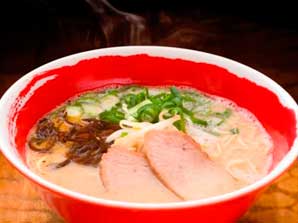Web Japan > Trends in Japan > Food & Travel > Fukuoka, a Center of History and Culture
Fukuoka, a Center of History and Culture
Region Serves as Bridge Between Japan and Asia
Situated in the northern part of Kyushu, the southernmost of Japan's four main islands, Fukuoka Prefecture has a unique local culture and cuisine that has developed over its long history. Its proximity to China and the Korean Peninsula has made it a gateway between Japan and the rest of Asia, not to mention a vital transportation hub. Among its historic attractions are the ruins of Dazaifu, an ancient government office, while the many small islands lying off the coast further captivate visitors. Fukuoka is also renowned for its fresh seafood and many street-side food stalls.
Commerce and CultureFukuoka is bordered by the ocean to the north, east, and west, and each of its coastlines has a unique character. Breathtaking views and outdoor activities can be enjoyed in the area's mild climate.
The prefectural capital of Fukuoka City overlooks the Port of Hakata, a harbor that has long facilitated the region's prosperity through trade with other parts of Asia. In addition to being the administrative and economic heart of the prefecture, Fukuoka is a lively commercial center from which trends in culture and fashion filter out to other parts of Japan. International flights from a variety of countries fly into and out of this "gateway to Asia," and the city's shops make it easy for tourists to satisfy their urge to splurge.
Fukuoka also boasts popular annual festivals with long histories. The Hakata Dontaku Festival, which takes place on May 3-4, dates back to the twelfth century. Originally a means of celebrating the New Year, it is now a major event in which about 20,000 residents parade through the city dressed in a variety of costumes, attracting as many as two million spectators.
Another local festival, the 760-year-old Hakata Gion Yamakasa, takes place over the first 15 days of July. Ten-meter-tall yamakasa (giant parade floats) decorated with brightly colored traditional figurines are positioned for display throughout the city. The most exciting part of the festivities, however, occurs on the final day. Taking their signal from the beat of taiko drums, teams of men hoist mikoshi (portable shrines) weighing as much as a ton each onto their shoulders and race each other to the finish. This spectacle is particularly exciting when viewed up close.
History PreservedAround 30 minutes by train from Fukuoka City is the city of Dazaifu, which takes its name from a government office established 1,300 years ago for the purpose of governing Kyushu. Ancient Dazaifu played an important role as a base for diplomatic exchanges with China, and large numbers of history buffs flock to the historical park built around the office's remains.
Dazaifu Tenmangu is another of Dazaifu's historical attractions. This famous Shinto shrine is dedicated to Sugawara no Michizane, a scholar and politician now worshipped as the god of scholarship. Many people visit the shrine to pray and appreciate the beauty of its plum blossoms and other seasonal flowers.
Cheap and Cheerful CuisineNo trip to Fukuoka is complete until visitors have sampled the many unique local foods. One popular offering is Hakata ramen: thin, firm noodles in cloudy white pork broth, topped with finely chopped Welsh onions and slices of barbecued pork. Many visitors become instantly hooked on the rich flavor of the noodles steeped in the thick broth. Motsunabe and mizutaki are two more specialties not to be missed. The former is made of beef intestine cooked slowly in a soup base flavored with soy sauce and miso; vegetables are added before the dish is consumed. Mizutaki is a nabe (or hot pot) with broth made from chicken boiled slowly on the bone. When the base is finished, chicken, vegetables, and other ingredients are added and the mixture is dished up from a simmering pot.
Though all of these dishes can be found at restaurants, it is often more fun - not to mention cheaper - to head to one of Fukuoka's many yatai (outdoor dining stalls), which are popular among both residents and tourists alike. The prefecture's many fine varieties of sake and shochu (distilled liquor), moreover, make a fine complement to any local meal.
Natural beauty, history, and enticing local cuisine combine to make Fukuoka a truly fulfilling destination for tourists. (March 2010)
- asianbeat

- The Many Splendors of Amami Oshima (September 2009)
- Yufuin, the Ideal Place to Soak in a Spa (March 2009)




